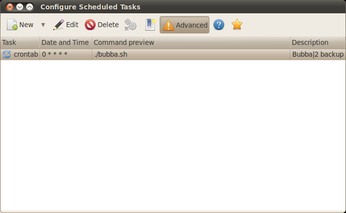Schedule Tasks GUI style with Gnome Schedule

Productivity Sauce
The cron tool lets you schedule system tasks, but if fiddling with cron's settings in a text editor is not your cup of tea, then the Gnome Schedule tool is right up your alley. Gnome Schedule is available in the software repositories of many popular Linux distros, so you can easily install it on your machine using your distro's package manager. On Ubuntu, you can do that by running the following command:
sudo apt-get install gnome-schedule
To launch Gnome Schedule, run the gnome-schedule command in the terminal. To create a new task, press the New button in the main toolbar. Select the type of task you want to create. Most often, you would want to create a recurrent task that runs at predefined intervals. To create a scheduled task, select the Recurrent task option, give the new task a descriptive name, and specify the command or script you want the task to perform. By default, the utility displays the output of the command or the script in a separate terminal window, but you can disable this feature by selecting the Suppress output option. Use then the options available in the Time & Date section to specify the desired schedule.
If you plan to add multiple jobs with similar settings, you can save the created task as a template. This way, you don't have to create every single task from scratch.
To check whether the added task works as it's supposed to, use the Run selected task button. You can also use this to run the task at any time. That's pretty much all there is to it. Gnome Schedule is not overloaded with features, but it makes it supremely easy to add and configure scheduled tasks.
comments powered by DisqusSubscribe to our Linux Newsletters
Find Linux and Open Source Jobs
Subscribe to our ADMIN Newsletters
Support Our Work
Linux Magazine content is made possible with support from readers like you. Please consider contributing when you’ve found an article to be beneficial.

News
-
Two New Distros Adopt Enlightenment
MX Moksha and AV Linux 25 join ranks with Bodhi Linux and embrace the Enlightenment desktop.
-
Solus Linux 4.8 Features Removes Python 2
Solus Linux 4.8 has been released with the latest Linux kernel, updated desktops, and a key removal.
-
Zorin OS 18 Hits over a Million Downloads
If you doubt Linux isn't gaining popularity, you only have to look at Zorin OS's download numbers.
-
TUXEDO Computers Scraps Snapdragon X1E-Based Laptop
Due to issues with a Snapdragon CPU, TUXEDO Computers has cancelled its plans to release a laptop based on this elite hardware.
-
Debian Unleashes Debian Libre Live
Debian Libre Live keeps your machine free of proprietary software.
-
Valve Announces Pending Release of Steam Machine
Shout it to the heavens: Steam Machine, powered by Linux, is set to arrive in 2026.
-
Happy Birthday, ADMIN Magazine!
ADMIN is celebrating its 15th anniversary with issue #90.
-
Another Linux Malware Discovered
Russian hackers use Hyper-V to hide malware within Linux virtual machines.
-
TUXEDO Computers Announces a New InfinityBook
TUXEDO Computers is at it again with a new InfinityBook that will meet your professional and gaming needs.
-
SUSE Dives into the Agentic AI Pool
SUSE becomes the first open source company to adopt agentic AI with SUSE Enterprise Linux 16.

